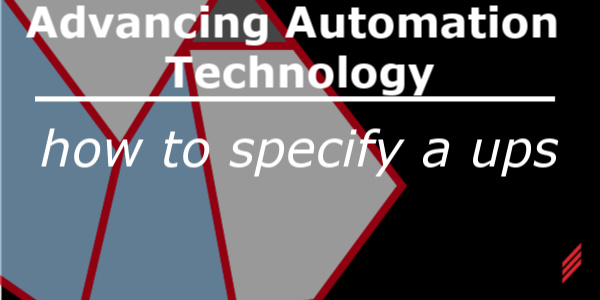Advancing Automation Technology - How to Specify a Hypervisor
by Jamie Godbout on Sep 8, 2016 2:39:06 PM

Advancing Automation Technology series will take an in-depth look into how the latest technology is being used to develop state-of-the-art control systems. We will select various software and hardware packages being used today, and provide you with the best practice techniques on how to apply them, and when you should consider applying each topic.
- Advancing Automation Technology With FactoryTalk® Batch - How is a FactoryTalk® Batch solution different from a traditional PLC project?
- Advancing Automation Technology - Part 1: Server Hardware Requirements
- Advancing Automation Technology - Server Rack Requirements
- Advancing Automation Technology - Layer 3 Core Switch Requirements
- Advancing Automation Technology - How to Specify a Domain Controller
- Advancing Automation Technology - How to Specify a Hypervisor
- Advancing Automation Technology - How to Specify a vCenter Server
- Advancing Automation Technology - How to Specify Shared Storage
- Advancing Automation Technology - How to Specify a KVM Console
- Advancing Automation Technology - How to Specify a UPS
 How to Specify a Hypervisor
How to Specify a Hypervisor
The hypervisor is the server that will host the virtual machines on your FactoryTalk Batch process control system. There are a couple of configurations you can choose from when designing your virtual platform. In each configuration the majority of the hardware requirements will be the same. The differences will be the number of hypervisors you need, and/or where you will store the virtual machines. Will you store them locally on the server or will you choose to use a shared storage device.
![]() The most basic configuration is a single hypervisor with integrated storage. In this configuration the hypervisor you choose will contain not only all of the required computing power and memory, but will also contain all of the hard drive storage arrays, and RAID controllers. This is by far the least expensive option and will satisfy 80% of the needs for a robust control system that does not require automatic fail over recovery. If there is a hardware failure with this configuration, all of the virtual machines hosted by this hypervisor will also fail.
The most basic configuration is a single hypervisor with integrated storage. In this configuration the hypervisor you choose will contain not only all of the required computing power and memory, but will also contain all of the hard drive storage arrays, and RAID controllers. This is by far the least expensive option and will satisfy 80% of the needs for a robust control system that does not require automatic fail over recovery. If there is a hardware failure with this configuration, all of the virtual machines hosted by this hypervisor will also fail.
 If you require a system that is fault tolerant and will remain running during a hardware failure of the hypervisor, then you will need a 2nd hypervisor and some sort of shared storage. The 2nd hypervisor will take over if the first hypervisor fails. However, you will need to store the virtual machines on a shared storage device to ensure the 2nd hypervisor can access the files. In this configuration the hypervisor does not require any storage arrays, as that function will be covered by the shared storage. Unfortunately, shared storage arrays are fairly expensive, and you will most likely require some sort of switch.
If you require a system that is fault tolerant and will remain running during a hardware failure of the hypervisor, then you will need a 2nd hypervisor and some sort of shared storage. The 2nd hypervisor will take over if the first hypervisor fails. However, you will need to store the virtual machines on a shared storage device to ensure the 2nd hypervisor can access the files. In this configuration the hypervisor does not require any storage arrays, as that function will be covered by the shared storage. Unfortunately, shared storage arrays are fairly expensive, and you will most likely require some sort of switch.
Hardware Requirements
The computer required to be a hypervisor needs to be powerful. Essentially the more RAM and CPU power allows more virtual machines you can run, giving you the most value out of your virtual system. The three items that require the most attention are RAM, CPU, and Storage. RAM is actually pretty easy, get the most you can afford. I prefer to start with 256GB, but you can probably get away with 128 GB for a smaller control system. RAM isn’t all that expensive.
The CPU gets a little more complicated, obviously you want the most effective CPU in the host, but in the case of CPUs more cores doesn’t always mean better. You definitely want dual processors, and higher speeds, but you need to do a little research with regard to the cost vs number of cores. I like to use the Passmark website (www.passmark.com) to check the measure of performance, and graph performance vs cost. Generally, what you find with processors is that there is a point of diminishing returns where each unit of increased performance tends to get very expensive. At that point it’s not worth paying for the extra cores, so you need to find a processor that gives you the best value for the dollar.
The last area that needs attention is the storage array and whether it should be integrated or shared. Quantity of storage is important when it comes to virtualize servers and you want to pay attention to the IOPs or how frequently the drives can read and write. I find this can be a bottle neck if you are not careful. I’ll post another blog discussing IOPs on virtual systems in the future. For now, let just say you want to maximize the number IOPs on your system for best performance. This means going with solid state drives, or as many hard drives with lower capacity as possible.
The important requirements are going to include:
- 19” Rack Mount Server
- Rack Mounting Slide Rails
- Cable Management Arm
- Dual Core Processors - look for the best processor vs cost on Passmark
- 128-256 GB of RAM (the most you can afford)
- Start with 1.8TB to 2.6TB of usable storage with some database storage
- I generally specify my virtual servers with 80 to 160GB hard drives, then create additional drives for file storage, databases, and so on. It can add up fast.
- If you require backup storage for disaster recovery, I recommend a separate appliance like EMC Data Domain, or another location to store your backups.
- Go for the hardware RAID controllers, don’t depend on software RAID.
- The hypervisor will work with RAID5 and if cost is a concern, that that may be sufficient, but you do take a significant IOPs penalty with RAID5. I prefer to go with RAID10, at least with the array that will store the VMs for the best performance. Of course RAID10 is the most expensive option because you need to have double the amount of hard drives to get the desired amount of storage.
- One nice thing about virtualization is that you can create a virtual network in the hypervisor. So I recommend getting the regular quad port Ethernet card, and an additional quad port card and use them as switch ports. This extra feature may save you from having to purchase a separate switch.
- CD or DVD drive
- Redundant power supplies (make sure the power supplies are big enough for the selected hardware. Dell will show a warning if this is a problem)
Software Requirements
The software you will need for the host hypervisor is the latest version of VMWare ESXi. You can download ESXi from VMWare web site and a license to activate the operating system will come with vSphere Essentials kit. Installing the ESXi is easy and requires very little interaction from the engineer. After the software has been installed and configured, you can access an embedded webpage by entering the IP address of the hypervisor in a web browser. In the web browser you will be shown a link to download vSphere client and that will give you some basic functionality to manage the virtual environment.
Summary
The hypervisor is the primary component in your virtualized system. You may only require a single hypervisor or you can scale it up and add additional hypervisors. The additional hypervisors may be used to fail over in the event of a hardware failure, or just to provide some extra horse power. The hypervisor does need to be powerful, and it should be where the majority of the server budget is spent.
You will need to acquire ESXi from VMWare to install as the operating system, and you have to decide whether or not to use integrated storage or some sort shared storage solution.
Click here to return to Part I of What Do You Need to Implement a FactoryTalk Batch Solution.
Click here to see my previous post discussing difference between a FactoryTalk Batch solution and a traditional PLC project.
If you have any questions concerning your process control system or require some assistance, please feel free to reach out to our Controls and Automation experts through our
About the Author:
Jamie has left Hallam-ICS to pursue other endeavors. If you have questions about this article or other Ignition questions, contact Tom Toppin, Process Controls Engineer.
About Hallam-ICS:
Hallam-ICS is an engineering and automation company that designs MEP systems for facilities and plants, engineers control and automation solutions, and ensures safety and regulatory compliance through arc flash studies, commissioning, and validation. Our offices are located in Massachusetts, Connecticut, New York, Vermont and North Carolina and our projects take us world-wide.
You May Also Like
These Related Stories

Advancing Automation Technology - How to Specify a UPS

How to Incorporate a Combustible Dust Safety into Design




No Comments Yet
Let us know what you think